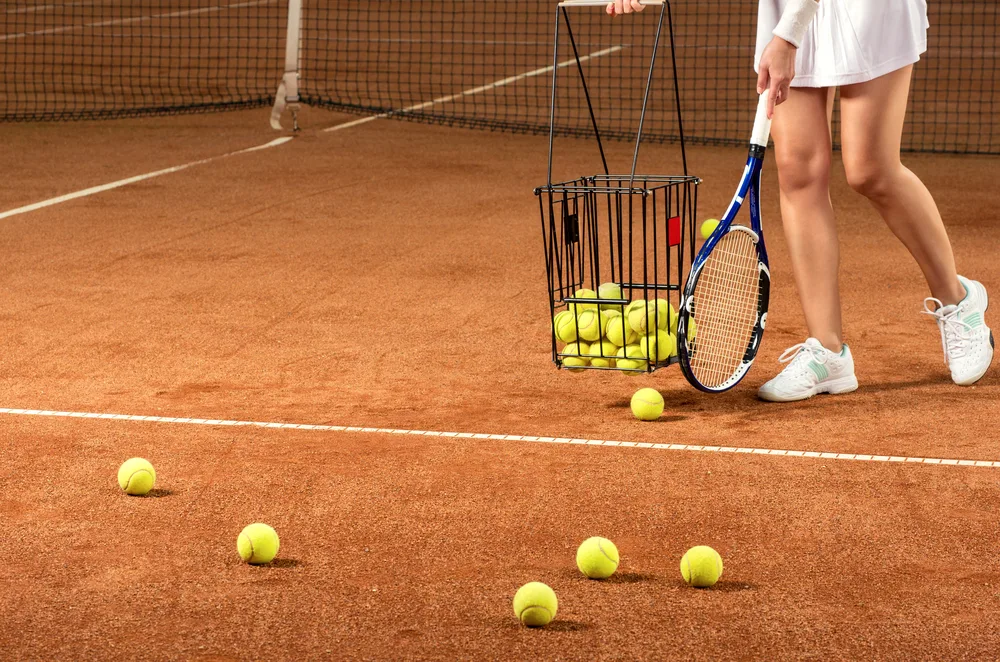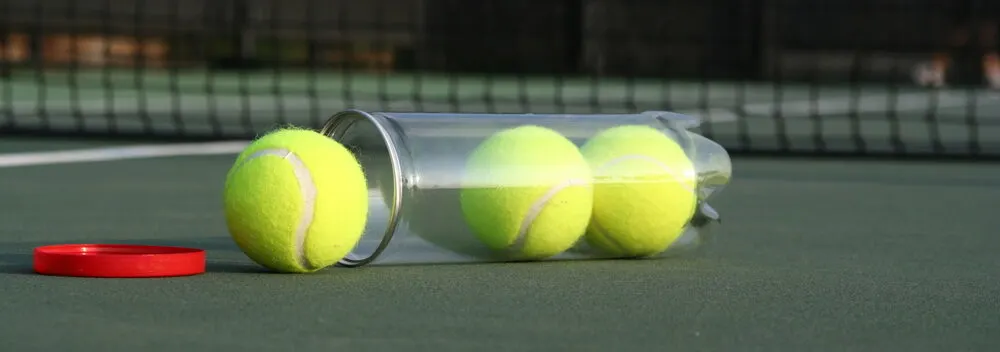
Practice tennis balls can make a huge difference in getting consistency down as a tennis player. The most challenging part is finding balls that fit into that mold. They need to last a long time with air pressure and felt being major parts.
In most cases, it’s always better to buy in bulk and try to get any added discount if possible. Even if purchasing just a few cans, these are the best five tennis balls for practice out right now.
Here are the 5 best practice tennis balls (ranked from 5 to 1).
5. Wilson U.S. Open/Championship Extra Duty

Since these two balls play pretty much the same, they share fifth place on this list. One has the branding as the official ball of the US Open, but they both use the same technology to make them solid options.
Included on the list of technology is an exclusive type of felt that Wilson developed to increase the playability and durability of this ball. Since this particular ball is designed for hard courts, it makes sense to have something that lasts a long time.
A lot of players will start out using this ball for an actual match or serious points. After that, they will switch it to a practice ball so that they can get some work in that way.
These balls last considerably longer time than some of the cheaper Wilson options. Being able to keep the air inside helps out tremendously for practice players.
The fact that Wilson balls are pretty much everywhere makes these common options for people to pick if they want to play with others. Having familiarity with the ball counts.
Pros
- Bright felt
- US Open branding
- Keeps air for a long time
Cons
- Expensive
- Clay court versions don’t last as long
4. Wilson Triniti

The Wilson Triniti tennis ball is a relative newcomer to the sport of tennis. After having pretty much the same balls for years and years, Wilson hopes to bring something different to the table with their eco-conscious and high-performance solution.
The first thing people noticed with this ball is that it’s packaged differently than others. Instead of coming in a pressurized canister, they are ready to go in unique, sustainable packaging.
The balls are designed as a way to make them last as much as four times longer than other options out there. This makes it a perfect solution for practice, even if the ball start to look a little beat up.
It’s common for the felt to look bad and the balls to get a little dark before they are actually out of air. People who can practice with balls that don’t look particularly fresh would benefit most from this option.
The balls are expensive, but if they can last at least twice as long, that makes them worth it. They sound a little bit different when they are hit, but a lot of players have adopted them as a choice for practice.
Pros
- Last a very long time
- Felt holds color well
- Eco-friendly
Cons
- Expensive
- Makes a weird noise when hit
3. Penn Championship Extra Duty

Take a look at any local tennis shop, and chances are they have cans of Penn Championship balls. They are seemingly everywhere, and the familiarity people have with them is just one of the reasons why they are high on the list. Practicing with the same type of tennis balls used in matches is always beneficial.
They also just happen to be a pretty solid tennis ball all around. Someone might even say that it’s the best overall value since they are a bit on the cheaper side compared to more premium solutions.
The ball at number one on the list is hard to compete with, but it does come at a more expensive price. For a slightly cheaper option that still works well, the Penn Championship Extra Duty is worth it.
Pros
- Very popular ball for practice and play
- Optik Felt helps with visibility
- Inexpensive
Cons
- Not quite as durable as the upper-tier option from Penn
- Felt fluffs up occasionally
2. Dunlop ATP Extra Duty

The Dunlop ATP World Tour Extra Duty balls have received solid reviews since getting a little bit of a revamp a few years ago. While most reviews focus on play, they make a great practice ball because of its durability and consistency.
A hard court option first and foremost, the ball is consistent from the very first hit. Players have mentioned that they do a great job keeping the felt looking clean and bright even as the ball ages.
That’s always a common complaint for people who play tennis and try to get the most out of their practice balls. Instead of having to squint to see them, they still look as they should.
Dunlop also seems to keep a relatively low price point compared to other competitors out there. They know that they aren’t synonymous with tennis balls like some of the other brands, but they still found a way to make it work.
Pros
- Bright visibility
- Keeps air very well
- Official ball out of the ATP World Tour
Cons
- Not as easy to find as some of the brands
- Some locations charge a premium price for Dunlop
1. Penn Pro Marathon Extra Duty

When considering everything, the top tennis ball for practice right now is the Penn Pro Marathon Extra Duty.
While it does cost a little bit more than the Championship option already talked about in this article, the extra amount of durability makes it perfect for practice.
The reason why so many people fell in love with this tennis ball in the first place is because of how it plays in a match.
Even if two people use a can of balls for three hard-fought sets, it still performs at a high level a little longer in a practice setting.
Penn relies heavily on their Smart Optik Felt, but they’ve also re-designed how to keep things tight with their air pressure.
Availability also makes a difference when looking at something like this. Too many companies are finding that they are everywhere, and tennis players don’t like to change up plans.
Instead of having to use new tennis balls for practice and then jump into something else for play, having Pro Penns around makes a big difference.
Pros
- Smart Optik Felt helps with vision
- Very durable
- Stays on the racquet a little bit longer
Cons
- Can feel a little heavier compared to other balls for first-time players
- More expensive than the Championship options
Getting the Most Out of Practice Tennis Balls

It’s never fun to have to purchase tennis balls as a player. where tennis players get their balls from can differ all the time.
The most important thing is owning enough to have sufficient practice. Eventually, they need cycled out and replaced with fresher options as well.
There’s always the option of buying brand-new cans of balls and opening them up for practice right away. They are going to play very well at first, but then they will start to show their age as time goes on.
Another option is to use match balls later on for practice. This works in some cases, as long as they weren’t abused and stored properly after the match. If used balls have been around for a super long time, they aren’t going to bounce the same way.
How To Get Practice Tennis Balls For Cheap
Professional players have the luxury of simply getting cases of tennis balls and using them for practice.
For those on a set budget and unable to buy so many brand new balls simply for practice, there are ways to maximize the life of practice tennis balls.
One thing to look into is a ball saver device. It can be argued just how much they work, but they do help keep what’s left of the ball’s pressure at a stabilized level.
Another option is to pick up used balls left at the local facility. Some people use balls for matches, and then simply leave them on the courts. It might not be of any use for them, but they could still make great practice options.
Finally, sharing the ball responsibility with someone else can lower the price of practice balls. A lot of players end up using a practice partner anyway, so going half-and-half will instantly provide a 50% discount.
Buying practice balls will always be part of the investment of being a successful tennis player. However, by getting quality balls and being a bit resourceful, practice doesn’t have to be as costly as one might think.
